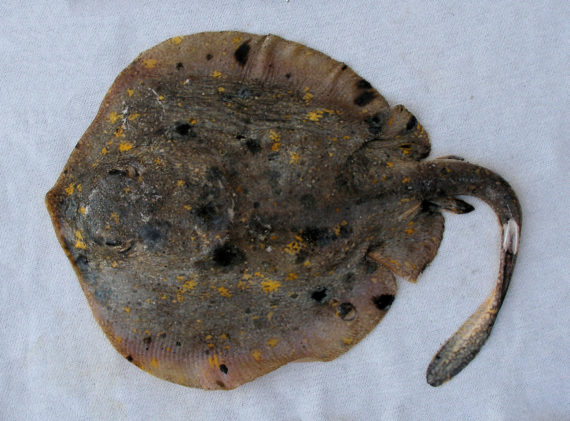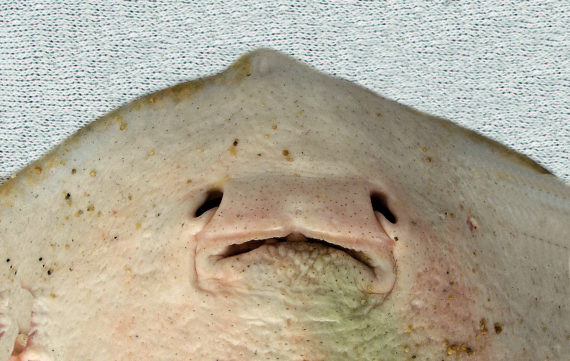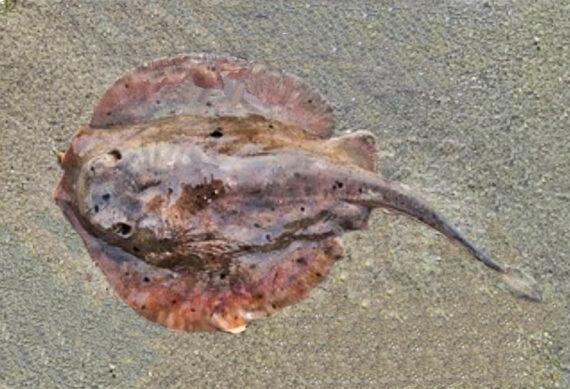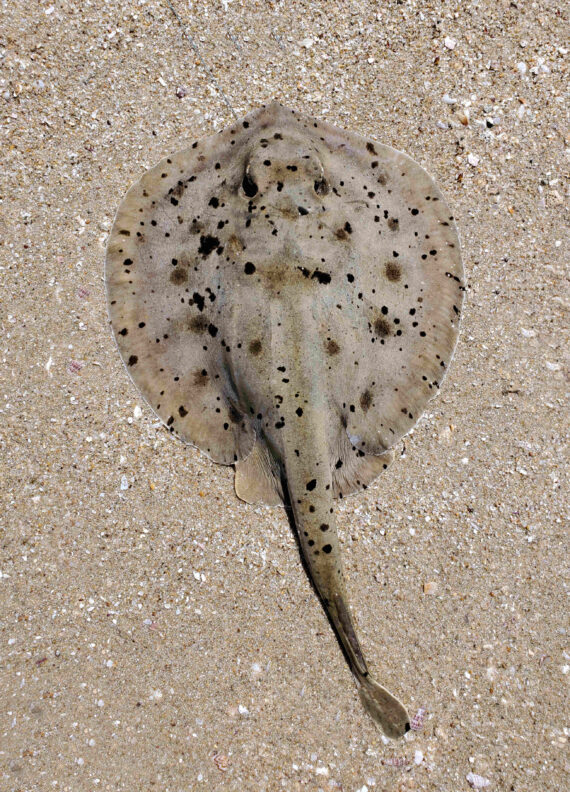Cortez Stingray, Urobatis maculatus


 Cortez Stingray, Urobatis maculatus. Fish provided by the commercial fishermen of the greater Los Cabos area, Baja California Sur, June 2011. Total Length: 38 cm (15 inches). Disc: 20 cm (7.9 inches) x 20 cm (7.9 inches). Tail: 18 cm (7.1 inches). Note that the stinger is not present in these photographs as they were surgically removed at the time of catch.
Cortez Stingray, Urobatis maculatus. Fish provided by the commercial fishermen of the greater Los Cabos area, Baja California Sur, June 2011. Total Length: 38 cm (15 inches). Disc: 20 cm (7.9 inches) x 20 cm (7.9 inches). Tail: 18 cm (7.1 inches). Note that the stinger is not present in these photographs as they were surgically removed at the time of catch.
 Cortez Stingray, Urobatis maculatus. Fish caught from coastal waters off Cabo San Lucas, Baja California Sur, June 2011. Total Length: 38 cm (15 inches). Disc: 20 cm (7.9 inches) x 20 cm (7.9 inches). Tail: 18 cm (7.1 inches). Catch, photograph and identification courtesy of Eli (obsessiveangling.wordpress.com).
Cortez Stingray, Urobatis maculatus. Fish caught from coastal waters off Cabo San Lucas, Baja California Sur, June 2011. Total Length: 38 cm (15 inches). Disc: 20 cm (7.9 inches) x 20 cm (7.9 inches). Tail: 18 cm (7.1 inches). Catch, photograph and identification courtesy of Eli (obsessiveangling.wordpress.com).
 Cortez Stingray, Urobatis maculatus. Fish caught from within the Morua Estuary, Puerto Peñasco, Sonora, April 2021. Length: 35 cm (14 inches). Catch courtesy of Carson Moore, Peoria, Arizona. Photograph and identification courtesy of Chris Moore, Peoria, Arizona.
Cortez Stingray, Urobatis maculatus. Fish caught from within the Morua Estuary, Puerto Peñasco, Sonora, April 2021. Length: 35 cm (14 inches). Catch courtesy of Carson Moore, Peoria, Arizona. Photograph and identification courtesy of Chris Moore, Peoria, Arizona.

 Cortez Stingray, Urobatis maculatus. Underwater photographs taken in Bahía Concep-ción, Baja California Sur, October 2024. Photographs and identifications courtesy of Bob Hillis, Ivins, Utah.
Cortez Stingray, Urobatis maculatus. Underwater photographs taken in Bahía Concep-ción, Baja California Sur, October 2024. Photographs and identifications courtesy of Bob Hillis, Ivins, Utah.
The Cortez Stingray, Urobatis maculatus, is a member of the American Round Stingray or Urotrygonidae Family, and is known in Mexico as raya redonda de Cortés. Globally, there are six species in the genus Urobatis, of which four are found in Mexican waters, one in the Atlantic and three in the Pacific Ocean.
The Cortez Stingray has a rounded flat body and they vary in color from brown to brownish gray with irregular, variably-sized, and widely-spaced dark brown to black blotches and spots. Their ventral side is are off white. Their discs are approximately 1.3 times longer than they are deep and have fairly straight front margins and a bluntly angular snout. Their eyes and spiracles are on top of their heads and their mouths, nostrils, and gill slits are on their ventral sides. Their pectoral wings are rounded. Their tails are short and stout, equal to or less than the disc length, and feature a large stinger and a large rounded caudal fin. These stingers are impressive, varying in length from 2.5 cm (1.0 inch) to 3.8 cm (1.5 inches). They have very smooth skin that is devoid of denticles or thorns.
The Cortez Stingray is a demersal species that resides over and within sandy and muddy bottoms. They are occasionally found in rocky reef areas at depths up to 91 m (300 feet), however they are most abundant at depths of less than 15 m (50 feet) and move to greater depths during cold-water episodes. The Cortez Stingrays reach a maximum of 42 cm (17 inches) in length with discs having a maximum of 31 cm (12 inches) in width, however, most have disc diameters of less than 25.4 cm (10 inches). They seek food by stirring the bottom sediment with their pectoral fins to dislodge small crustaceans, small fish, mussels, and worms on which they feed. Reproduction occurs via internal fertilization with embryos developing via aplacental vivparity with a gestation period of three months. Their pups are born alive and resemble miniature adults that are independent at birth. The Cortez Stingray is poorly studied with very limited information available about their lifestyle and behavioral patterns including specific details on age, growth, longevity, movement patterns, diet, habitat use, and reproduction.
The Cortez Stingray is a resident of Mexican waters of the Pacific but has a limited range being found from Guerrero Negro, Baja California, southward along the central and southwest coasts of Baja and throughout the Sea of Cortez.
The Cortez Stingray can be confused with the Blotched Stingray, Urotrygon chilensis (gray to gray brown coloration with no spots), the Reef Stingray, Urobatis concentricus (dark spots arranged in circles), and the Round Stingray, Urobatis halleri (dense dark brown spots with circular markings).
From a conservation perspective, the Cortez Stingray is currently classified as Data Deficient. They are fairly abundant in certain locations at certain times of the year. From a fishing perspective, they are only retained by subsistence fishermen and typically considered a “catch and release.”